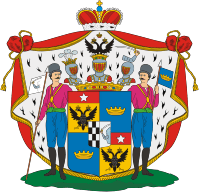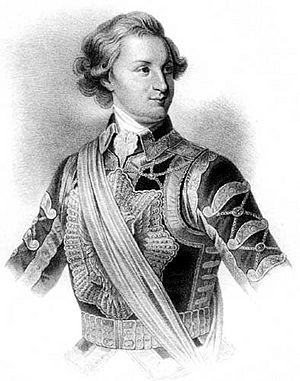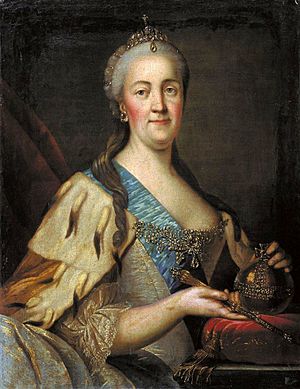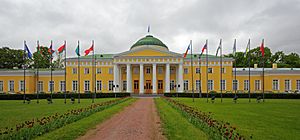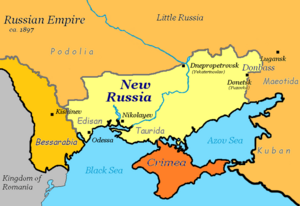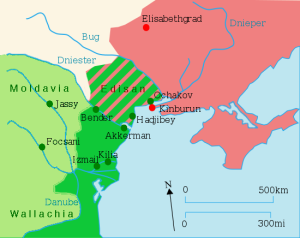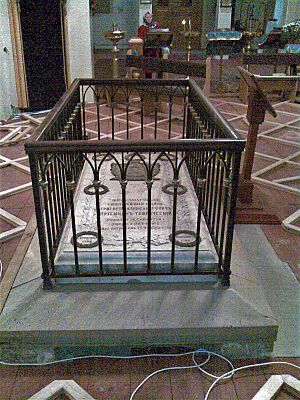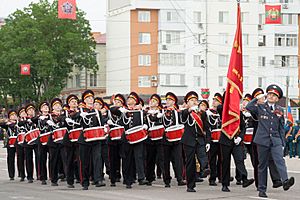Grigory Potemkin facts for kids
Quick facts for kids
Prince Grigory Aleksandrovich Potemkin-Tauricheski
|
|
|---|---|
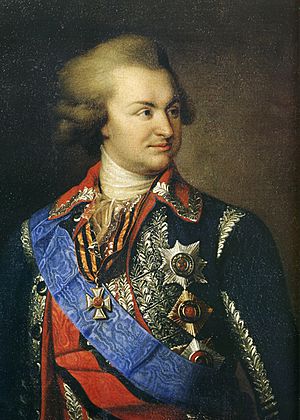
Non-contemporary portrait of
Potemkin in later life |
|
| President of the College of War | |
| In office 1774–1791 |
|
| Preceded by | Zakhar Chernyshev |
| Succeeded by | Nikolay Saltykov |
| Personal details | |
| Born | 11 October 1739 (N.S.) Chizhovo, Russian Empire |
| Died | 16 October 1791 (aged 52) (N.S.) Iași, Principality of Moldavia |
| Resting place | St. Catherine's Cathedral, Kherson, Ukraine |
| Spouse | Catherine II of Russia (possible) |
| Children | Elizabeth Grigorieva Temkina (alleged) |
| Parents |
|
| Military service | |
| Allegiance | |
| Branch/service | Imperial Russian Army |
| Years of service | 1762–1791 |
| Rank | Field marshal |
| Commands | Black Sea Fleet, Imperial Russian Army |
Prince Grigory Aleksandrovich Potemkin-Tauricheski (/pəˈtɛmkɪn/, also UK: /pɒˈ-/, US: /poʊˈ-, pəˈtj[unsupported input]-/;, Russian: Князь Григо́рий Алекса́ндрович Потёмкин-Таври́ческий, tr. Knjaz' Grigórij Aleksándrovich Potjómkin-Tavrícheskij, IPA: [ɡrʲɪˈɡorʲɪj ɐlʲɪkˈsandrəvʲɪɕ pɐˈtʲɵmkʲɪn tɐˈvrʲitɕɪskʲɪj]; October 11 [O.S. September 30] 1739 – October 16 [O.S. October 5] 1791), also known as Grigory Aleksandrovich Potyomkin-Tavricheskiy, was an important Russian military leader and government official. He was a close advisor to Catherine the Great, the Empress of Russia.
Potemkin came from a noble family that was not very rich. He first gained Catherine's attention by helping her take power in 1762. He then became a skilled military commander during the Russo-Turkish War (1768–1774). He became a very trusted friend and advisor to Catherine. She gave him many important titles, including Prince of the Russian Empire. He was also a Grand Admiral and led all of Russia's land and irregular forces.
Some of Potemkin's major achievements include peacefully adding Crimea to Russia in 1783. He also led Russia to victory in the second Russo-Turkish War (1787–1792). He died during peace talks that ended this war.
In 1775, Potemkin became the governor of Russia's new southern regions. He worked hard to settle these wild lands. He founded important cities like Kherson, Nikolayev, Sevastopol, and Ekaterinoslav. Ports in this area became bases for his new Black Sea Fleet.
Potemkin was known for his love of fancy things. He oversaw the building of many important structures, like the Tauride Palace in Saint Petersburg. His rule in the south is linked to the idea of "Potemkin villages." These were supposedly fake villages built to trick visitors into thinking the area was richer than it was.
Biography of a Russian Leader
Early Life and Education
Grigory Potemkin was born in 1739 in a village near Smolensk. His family were noble landowners, but not very wealthy. His father, Alexander Potemkin, was a war veteran. His mother, Daria Vasilievna Kondyreva, was known for being smart.
After his father died in 1746, his mother moved the family to Moscow. Potemkin went to a school connected to the University of Moscow. He was good at languages and interested in the Russian Orthodox Church. In 1750, at age eleven, he joined the army, which was common for noble children. He later became one of the first students at the university itself. He was talented in Greek and theology.
Potemkin won a gold medal from the university in 1757. However, he later studied less and was expelled. He then rejoined the Guards, where he did very well.
Joining Catherine's Court
In June 1762, Grigory Orlov, a close associate of Catherine, led a palace coup. This event removed Emperor Peter III and made Catherine II the Empress. Sergeant Potemkin helped his regiment in this revolt. During the coup, Catherine was reviewing her troops. Potemkin quickly helped her by providing a missing part for her sword or hat.
After the coup, Catherine noticed Potemkin and promoted him. He was later made a gentleman of the bedchamber. Potemkin was known for being a talented mimic, and his imitation of Catherine was well-liked.
Potemkin became part of Catherine's group of advisors. In 1762, he went on his only foreign trip to Sweden to share news of the coup. When he returned, he was given a role as a state official. For a time, Potemkin faced some personal difficulties and withdrew from court. However, he returned and took on new roles, including overseeing army supplies. He also became a Guardian of Exotic Peoples, which was an important political job.
Military Achievements
Potemkin became a Major-General in the cavalry. He showed great skill in his first battle, helping to push back Tatar and Turkish horsemen. He also fought in Russia's victory at the Battle of Kamenets. Potemkin was often in action and did very well at the Battle of Prashkovsky. His commander recommended him to Catherine for his bravery.
Potemkin continued to advance with his army. He fought bravely at the capture of Jurja, earning the Order of St. Anna. At the Battle of Larga, he won the Order of St. George. He fought well during the defeat of the main Turkish army that followed. When he visited St. Petersburg, Empress Catherine invited him to dine with her many times.
Potemkin won more military honors at the front. After a break in fighting, he returned to St. Petersburg. It seems Catherine missed him, and he became one of her closest advisors. In 1773, Potemkin returned to the war as a Lieutenant-General. He came back to St. Petersburg as a war hero.
Trusted Advisor to Catherine II
Potemkin returned to court in January 1774. The political situation was complicated. A rebel leader named Yemelyan Pugachev had a large army. Also, Catherine's son Paul turned eighteen and started gaining his own supporters. Potemkin quickly rose in political importance, especially because of his military advice.
In March 1774, he became a Lieutenant-Colonel in the Preobrazhensky Guards. He also became captain of the Chevaliers-Gardes in 1784. He quickly received many important appointments. These included Governor-General of Novorossiya, a member of the State Council, and Commander-in-Chief of the Cossacks. These positions made him very wealthy, and he lived a grand lifestyle. He also received many prestigious awards from Russia and other European countries.
Catherine and Potemkin remained very close friends. Their friendship continued to be a major part of their lives.
Foreign Policy and Expansion
Potemkin's first major task was foreign policy. He helped with Catherine's plan for Armed Neutrality, which aimed to protect neutral ships during wartime. However, his main interest was Russia's southern regions.
His plan, called the Greek Project, aimed to create a new empire around the Turkish capital of Constantinople. To do this, Russia needed to improve relations with Austria. Potemkin met with Austria's ruler, Joseph II, in 1780. Their alliance was kept secret for almost two years.
Potemkin focused on Russia's southern provinces. He was busy founding cities and building his new Black Sea Fleet. The Crimean Khanate, which was independent but under Russian influence, was in chaos. By July 1783, Potemkin successfully arranged for Crimea to peacefully join Russia. The Kingdom of Georgia also accepted Russian protection around this time. Catherine rewarded Potemkin with a large sum of money, which he used to build the Tauride Palace in St. Petersburg.
Developing Southern Russia
Potemkin returned to St. Petersburg in November 1783. He was promoted to Field Marshal when Crimea officially became part of Russia. He also became President of the College of War. The region of Taurida (Crimea) was added to Novorossiya (meaning 'New Russia'). Potemkin moved south in March, becoming known as the "Prince of Taurida." He had been in charge of Russia's southern provinces since 1774, and he often expanded these areas through military actions.
He had his own court, which was almost as grand as Catherine's. By the 1780s, he had many clerks and his own minister to manage daily affairs. Potemkin also dealt firmly with the Cossacks, who lived in the region. By the time he died, the Cossacks were under control.
City Building Projects
Potemkin began a period of building new cities. His first project was Kherson, started in 1778. It was meant to be a base for his new Black Sea Fleet. Construction was slow and costly. Next, he built the port of Akhtiar, which became Sevastopol. He also built Simferopol as the capital of Crimea.
His biggest challenge was building Ekaterinoslav (meaning 'The glory of Catherine'), now Dnipro. A more successful city was Nikolayev (now Mykolaiv), which he founded in 1789. Potemkin also started the redesign of Odessa after it was captured from the Turks. This became one of his greatest city planning successes.
Potemkin's Black Sea Fleet was a huge project. By 1787, it had many warships, making Russia a strong naval power. Potemkin also encouraged hundreds of thousands of settlers to move to his territories. The populations of Novorossiya and Azov doubled during this time. Immigrants included Russians, foreigners, and even some British convicts.
In 1787, Catherine visited the south, traveling down the Dnieper river. When she visited Sevastopol, Austria's Joseph II, who was with her, noted that "The Empress is totally ecstatic... Prince Potemkin is at the moment all-powerful."
The "Potemkin Village" Story
The idea of the Potemkin village came from Catherine's visit to the south. Some critics claimed that Potemkin used painted fake buildings to trick Catherine. They said he made her believe the area was much richer than it was. It was even said that thousands of peasants were moved around to appear happy and well-fed for her visit.
While Potemkin certainly wanted Catherine to see the best of what he had built, it is unlikely that the deception was as widespread as claimed. Some officials did hide poverty by building false houses. However, the Prince of Ligne, who traveled with the group and explored on his own, later said the claims were false.
Leading the Army
Potemkin remained in the south. In August 1787, another Russo-Turkish war began. Potemkin was Russia's commander-in-chief. His enemies wanted to take back lands they had lost in the previous war. Potemkin had his own Yekaterinoslav Army, and he also had the Black Sea Fleet. He was responsible for working with Russia's Austrian allies.
The Turks were pushed back in early battles. Potemkin's forces won a naval battle against the Turks with few losses. They then began the siege of Ochakov, a strong Turkish fort. Meanwhile, St. Petersburg was threatened by Sweden in the Russo-Swedish War. Potemkin did not send regular updates, which worried Catherine.
Potemkin disagreed with General Alexander Suvorov and Catherine about attacking Ochakov. Finally, on December 6, the attack began, and the city was captured in four hours. This was a great success for Potemkin. Nearly ten thousand Turks were killed, while Russia lost about two-and-a-half thousand soldiers. Catherine praised him, saying he had silenced his critics.
Potemkin then visited the naval yard and founded Nikolayev. He traveled to St. Petersburg in February 1789. In May, he returned to the front.
The summer and autumn of 1789 saw many victories against the Turks. These included the Battle of Focşani in July, and the Battle of Rymnik in September. The capture of Kaushany and Hadjibey (modern Odessa) also happened. The Turkish fort at Akkerman surrendered in late September. The large fort at Bender surrendered in November without a fight. Potemkin set up a grand court in Iași, the capital of Moldavia. He even started a newspaper there. He was given the new title of "Grand Hetman of the Black Sea and Yekaterinoslav Cossack Hosts." In March, he took personal control of the Black Sea fleet as Grand Admiral.
In July 1790, the Russian Baltic Fleet was defeated by the Swedish navy. However, this led to a peace treaty, ending the threat of invasion from Sweden. This freed up military resources for the war against the Turks. Potemkin moved his court to Bender, and there were more successes against Turkey. By the end of November, only one major target remained: the Turkish fortress of Izmail. At Potemkin's request, General Suvorov led the attack, which was costly but successful. This victory was celebrated with Russia's first national anthem, "Let the thunder of victory sound!"
After two years, Potemkin returned to St. Petersburg. He faced the threat of war against a group of countries including Britain and Prussia. He also had to deal with political issues at court. Catherine and Potemkin disagreed on military strategy. Luckily for Russia, the alliance against them fell apart. The threat of a wider war ended. Potemkin was given the power to negotiate with the Turks. Catherine sent him a note saying, "Goodbye my friend, I kiss you."
Death and Burial
Potemkin became ill in the city of Iași. He remained busy, working on peace talks and planning for the army. He felt better for a short time but then became ill again. On October 16 [O.S. October 5] 1791, Potemkin died in the open steppe, about 60 kilometers from Iași. Some historians have suggested he was poisoned, but others believe he died from bronchial pneumonia.
Potemkin was embalmed, and a funeral was held in Iași. He was buried eight days after his death. Catherine was very sad and ordered social life in St. Petersburg to stop. Many in the military also felt his loss deeply.
Potemkin had used state money as his own, so his financial matters were complicated. Catherine bought the Tauride Palace and his art collection from his estate. She also paid off his debts.
Catherine's son Paul, who became Emperor in 1796, tried to undo many of Potemkin's changes. The Tauride Palace was turned into a barracks. The city of Gregoripol, named after Potemkin, was renamed.
Potemkin's grave survived an order from Paul to destroy it. His remains were believed to be in his tomb at St. Catherine's Cathedral in Kherson. In October 2022, his remains were reportedly moved from his tomb and taken to Russia. This was the ninth time Potemkin's remains had been moved.
Personality and Character
Potemkin was described as having a mix of qualities. He could be arrogant and demanding, but also charming, warm, and kind. He was seen as "colossal like Russia," with a mix of greatness and smallness, laziness and activity, bravery and shyness.
Potemkin was a hard worker but also loved luxury. He was very fond of jewelry. He was sensitive about his appearance, especially his lost eye. He only had portraits made of him twice, both times from an angle that hid his injury.
Potemkin was also an intellectual. He had "natural abilities [and] an excellent memory." He was interested in history and loved classical music and opera. He enjoyed all kinds of food. He was a practical politician, and his political ideas were very Russian. He believed in the strength of the Tsarist autocracy.
Potemkin was a figure who caused debate. Some criticized him for being lazy, corrupt, and extravagant. Others praised his intelligence, strong personality, vision, courage, and generosity. While not a military genius, he was "seriously able" in military matters.
Family Life
Potemkin did not have any children who were legally recognized as his heirs.
However, he had influential relatives. His sister Maria married a Russian senator, and their son Alexander became a decorated general under Potemkin. Their daughter Ekaterina had children, including the famous General Nikolay Raevsky, who was Potemkin's great-nephew. A distant nephew, Felix Yusupov, was involved in the murder of Rasputin in 1916.
Legacy and Influence
Even though Paul I tried to lessen Potemkin's importance, his name became part of many common phrases and items:
- A hundred years after Potemkin's death, the Battleship Potemkin was named in his honor. This ship became famous for its role in the Russian Revolution of 1905. It was also featured in Battleship Potemkin, a famous Soviet movie.
- The large staircase in Odessa, seen in The Battleship Potemkin, is now known as the Potemkin Stairs.
- The phrase Potemkin village became common around the world, even though its origin is likely fictional.
- The Grigory Potemkin Republican Cadet Corps, a special school in Transnistria, is named after him.
- In October 2022, news reports stated that Russian armed forces had removed Potemkin's remains from his grave in St. Catherine's Cathedral, Kherson, Ukraine.
Images for kids
See also
 In Spanish: Gregorio Potemkin para niños
In Spanish: Gregorio Potemkin para niños


